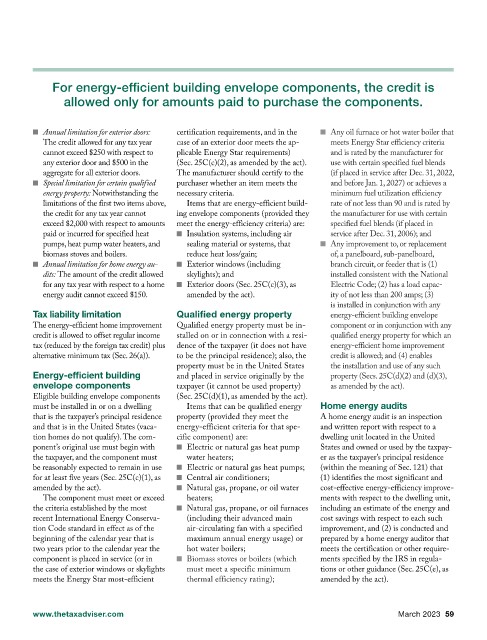Page 173 - TaxAdviser_Jan_Apr23_Neat
P. 173
For energy-efficient building envelope components, the credit is
allowed only for amounts paid to purchase the components.
■ Annual limitation for exterior doors: certification requirements, and in the ■ Any oil furnace or hot water boiler that
The credit allowed for any tax year case of an exterior door meets the ap- meets Energy Star efficiency criteria
cannot exceed $250 with respect to plicable Energy Star requirements) and is rated by the manufacturer for
any exterior door and $500 in the (Sec. 25C(c)(2), as amended by the act). use with certain specified fuel blends
aggregate for all exterior doors. The manufacturer should certify to the (if placed in service after Dec. 31, 2022,
■ Special limitation for certain qualified purchaser whether an item meets the and before Jan. 1, 2027) or achieves a
energy property: Notwithstanding the necessary criteria. minimum fuel utilization efficiency
limitations of the first two items above, Items that are energy-efficient build- rate of not less than 90 and is rated by
the credit for any tax year cannot ing envelope components (provided they the manufacturer for use with certain
exceed $2,000 with respect to amounts meet the energy-efficiency criteria) are: specified fuel blends (if placed in
paid or incurred for specified heat ■ Insulation systems, including air service after Dec. 31, 2006); and
pumps, heat pump water heaters, and sealing material or systems, that ■ Any improvement to, or replacement
biomass stoves and boilers. reduce heat loss/gain; of, a panelboard, sub-panelboard,
■ Annual limitation for home energy au- ■ Exterior windows (including branch circuit, or feeder that is (1)
dits: The amount of the credit allowed skylights); and installed consistent with the National
for any tax year with respect to a home ■ Exterior doors (Sec. 25C(c)(3), as Electric Code; (2) has a load capac-
energy audit cannot exceed $150. amended by the act). ity of not less than 200 amps; (3)
is installed in conjunction with any
Tax liability limitation Qualified energy property energy-efficient building envelope
The energy-efficient home improvement Qualified energy property must be in- component or in conjunction with any
credit is allowed to offset regular income stalled on or in connection with a resi- qualified energy property for which an
tax (reduced by the foreign tax credit) plus dence of the taxpayer (it does not have energy-efficient home improvement
alternative minimum tax (Sec. 26(a)). to be the principal residence); also, the credit is allowed; and (4) enables
property must be in the United States the installation and use of any such
Energy-efficient building and placed in service originally by the property (Secs. 25C(d)(2) and (d)(3),
envelope components taxpayer (it cannot be used property) as amended by the act).
Eligible building envelope components (Sec. 25C(d)(1), as amended by the act).
must be installed in or on a dwelling Items that can be qualified energy Home energy audits
that is the taxpayer’s principal residence property (provided they meet the A home energy audit is an inspection
and that is in the United States (vaca- energy-efficient criteria for that spe- and written report with respect to a
tion homes do not qualify). The com- cific component) are: dwelling unit located in the United
ponent’s original use must begin with ■ Electric or natural gas heat pump States and owned or used by the taxpay-
the taxpayer, and the component must water heaters; er as the taxpayer’s principal residence
be reasonably expected to remain in use ■ Electric or natural gas heat pumps; (within the meaning of Sec. 121) that
for at least five years (Sec. 25C(c)(1), as ■ Central air conditioners; (1) identifies the most significant and
amended by the act). ■ Natural gas, propane, or oil water cost-effective energy-efficiency improve-
The component must meet or exceed heaters; ments with respect to the dwelling unit,
the criteria established by the most ■ Natural gas, propane, or oil furnaces including an estimate of the energy and
recent International Energy Conserva- (including their advanced main cost savings with respect to each such
tion Code standard in effect as of the air-circulating fan with a specified improvement, and (2) is conducted and
beginning of the calendar year that is maximum annual energy usage) or prepared by a home energy auditor that
two years prior to the calendar year the hot water boilers; meets the certification or other require-
component is placed in service (or in ■ Biomass stoves or boilers (which ments specified by the IRS in regula-
the case of exterior windows or skylights must meet a specific minimum tions or other guidance (Sec. 25C(e), as
meets the Energy Star most-efficient thermal efficiency rating); amended by the act).
www.thetaxadviser.com March 2023 59

